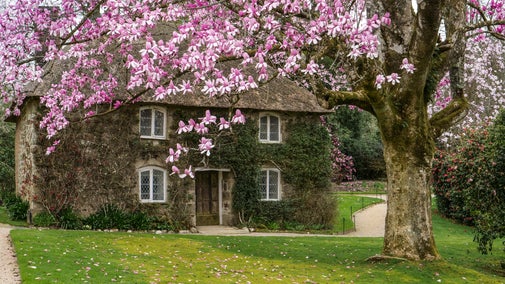
Discover more at Lanhydrock
Find out when Lanhydrock is open, how to get here, the things to see and do and more.

There are lots of things to look out for while exploring the outdoors, from a wide variety of wildlife species to the hidden history of the Lanhydrock estate. Here, we round up some of the things you can expect to see.
There are four circular routes around the Lanhydrock estate, each of which provides unique views of the natural surroundings and the wildlife habitats that live there. Stroll towards the Victorian swimming pool, head out around the parkland or really stretch your legs by taking the historic deer park route.
This long walk is the best way to take in the wider Lanhydrock Estate. See the marks generations have left on the estate, from the medieval deer wall to the more recent tin streaming remains and quarry.
Enjoy spending time outside at the countryside places we care for? You can help us to keep them safe and enjoyable by following a few simple guidelines during your visit. To find out more, read the Countryside Code.
As well as spoiling the beauty of Lanhydrock's landscape, litter can be dangerous for wildlife, which can easily become entangled or mistake it for food. Litter can also act as fuel for wildfires.
If you have a picnic or produce any other litter during your visit, please keep hold of it until you find a bin, or take it home with you.

There are some hidden historical gems to find as you explore the Lanhydrock countryside.
The swimming pool was regularly used by the Victorian Agar-Robartes family; you can still see the outline of the old changing room. Today it is a haven for wildlife, including palmate newts who love to bask in the warm water by the steps.
Lanhydrock was once home to a medieval deer park. You can spot the remaining stretches at different points around the parkland.
The haha consists of a raised wall and ditch, designed to contain livestock without interrupting the view with ugly fences. The name is said to derive from the response whenever an unfortunate visitor failed to notice the edge and took a tumble.
The remains of an old tin works here on the estate, now a haven for wildlife.
The historic avenue was planted in celebration of the end of the Civil War.

Lanhydrock is home to hundreds of different wildlife species, some common, others quite rare.
The estate is the best place in Cornwall to spot bats, with 13 of the UK's 18 species recorded here. If you’re exploring the estate at dusk, you’re sure to see them flitting about.
A 'corridor' of pollinator-friendly grasses and wildflowers at Lanhydrock helps bees and butterflies to find the plants and flowers they need to thrive.
During the summer months, the parkland is full of butterfly species, including meadow brown, painted lady, orange tip, large white, tortoiseshell, speckled wood, gatekeeper, common blue, ringlet and large skipper.
The swimming pool is home to frogs, tadpoles and palmate newts. These newts are the smallest UK species, and are usually found in shallow acidic ponds on heaths and moorland. It’s unusual to find them in woodland and in such deep water.
However, this part of Cornwall used to be covered in moorland, so perhaps the descendants of the newts that thrived back then have managed to keep a stronghold in the swimming pool.
You may notice logs and felled trees as you walk around the estate. Standing and deadwood timber is left in place as it’s a great wildlife habitat. In fact, a dead tree can provide a home or food source for hundreds of species of birds, mammals, reptiles and invertebrates.
The area near the swimming pool is a good place to spot oil beetles. These rare creatures grow very big so are easy to spot.
Be careful if you try to touch them. Not only are they rare in the UK (several types are completely extinct), but they squirt out an oily substance when disturbed, which can really sting.

Find out when Lanhydrock is open, how to get here, the things to see and do and more.

Find out how to take part in outdoor activities across the Lanhydrock estate, from cycling and running to horse riding and fishing.

The garden at Lanhydrock is a must for people who love plants, stunning views and a place to relax. Read more about what to expect when you visit.

Discover what family-friendly activities are on offer at Lanhydrock, from visiting the reimagined Victorian nursery to exploring the estate by bicycle.

Find out where to stop for food and drink on the Lanhydrock estate, along with the best places to shop for souvenirs and gifts.

Find out where you can take your dogs at Lanhydrock, and discover the dog-friendly walks that meander across this impressive estate. Lanhydrock is a three pawprint rated place.

Plan a visit to one of the special countryside places in our care and discover the benefits of being in the great outdoors. Pack your walking boots and get ready to explore woodlands, valleys and rivers.

Explore some of the finest landscapes in our care on coastal paths, accessible trails, woodland walks and everything in between. Find the best places to walk near you.

Cornwall has a wealth of woodlands, bridleways, trails and paths to explore including a wet willow woodland. Experience fresh air outdoors with the whole family this summer and look out for an abundance of wildlife and butterflies that call this place home.